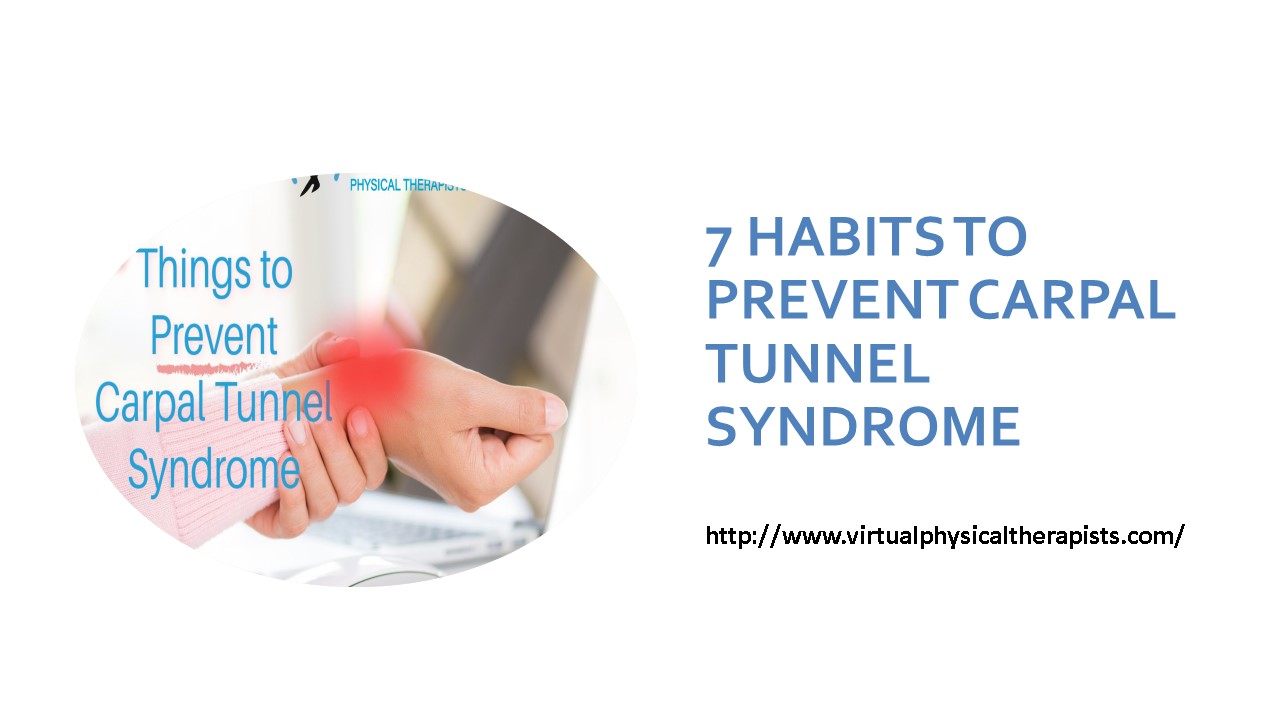7 HABITS TO PREVENT CARPAL TUNNEL SYNDROME - PowerPoint PPT Presentation
Title:
7 HABITS TO PREVENT CARPAL TUNNEL SYNDROME
Description:
Carpal Tunnel Syndrome is due to compression of the median nerve. There are habits that you can do to prevent Carpal Tunnel Syndrome! – PowerPoint PPT presentation
Number of Views:2
Title: 7 HABITS TO PREVENT CARPAL TUNNEL SYNDROME
1
7 HABITS TO PREVENT CARPAL TUNNEL SYNDROME
http//www.virtualphysicaltherapists.com/
2
Are you worried about getting Carpal Tunnel
Syndrome, or do you already have some warning
signs of pain, tingling, and numbness in your
thumb and wrist? If your job or favorite pastime
places strain on your wrist, you should learn
ways to minimize the stress to prevent trauma and
downtime from employment and your favorite
hobbies. The good news is that with a little bit
of education, there is a lot you can do to
protect yourself and prevent your symptoms from
getting worse.
3
- Carpal Tunnel Syndrome is caused by compression
of your median nerve as it goes through a narrow
Carpal tunnel to your wrist. The median nerve
provides sensation to your thumb and first three
fingers. Overuse, trauma, and inflammatory
medical conditions can cause swelling in your
wrist, reducing the space through the tunnel, and
causing your nerve to get squeezed, resulting in
symptoms.
4
If compression is the cause of Carpal Tunnel
Syndrome, reducing the pressure on the median
nerve while it travels across the wrist is
critical. Reducing the stress and strain on your
hands and wrists will help reduce and may even
prevent symptoms. If you are symptomatic a
physical or occupational therapy consult is
beneficial as they will evaluate and outline a
specific program tailored to your specific needs.
5
7 Habits to Prevent Carpal Tunnel Syndrome
- 1. Maintain good posture
- Poor posture causes you to drop your head forward
and round your shoulders. This posture causes
stress on the bones, muscles, discs, and nerves
in your neck and can set off a chain reaction
that can lead to problems with the median nerve.
Short periods of slouching are acceptable, but
when we slouch all day and sleep in the same
position, the muscles, bones, and disc constantly
get the same pressure which eventually leads to
breakdown. Maintaining good posture more than
poor is critical to reducing musculoskeletal
problems.
6
- 2. Keep Wrist Neutral
- Keeping your wrist in a straight, neutral
position takes the pressure off your median
nerve. Using your wrist at end range positions of
flexion or extension stresses the median nerve.
3. Night Brace Wearing a wrist brace when you
sleep will prevent you from sleeping with your
wrist in an extreme position of being flexed or
extended. It might also help to wear it during
activities that trigger your symptoms.
7
- 4. Give Yourself a Break
- If your work or hobby requires intense use of
your wrist and hands, give yourself a break every
hour. Go for a short one-minute walk around the
house. Stretch your whole body into extension by
leaning backward. (Sitting places you in a flexed
posture.) A ten-minute break every hour is ideal.
This is especially important if you use tools
that vibrate or make you apply a lot of force.
8
- 5. Stretch Often
- When you take those breaks, perform simple wrist
stretches - Prayer Stretch
- Step 1 Put your hands together under your chin
in a prayer position. - Step 2 Push your hands down to your waist until
you feel a moderate stretch. Hold for up to 30
seconds. Repeat between two and four times. - Finger Abduction
- 1. Make a fist
- 2. Release your fingers and fan them out.
- 3.Stretch them as far as you can. Repeat 5-10
times
9
- 6. Change It Up
- Try to avoid using the same hand and wrist
motions repeatedly. For example, if you have a
task that you always do with your right hand, do
it with your left instead. Or, mix up your tasks
as much as possible to give your muscles a break.
10
- 7. Anti-inflammatory diet
- Inflammation is a protective mechanism that
allows your body to defend itself against
infection, illness, or injury. It can also occur
on a chronic basis, which can lead to various
diseases. Eating unhealthy foods, drinking
alcohol or sugary beverages, and getting little
physical activity are all associated with
increased inflammation. Choose a balanced diet
that cuts out processed products and boosts your
intake of whole, anti-inflammatory,
antioxidant-rich foods. Avoid or minimize sugary
foods and beverages, processed meat, excessive
alcohol, and foods high in refined carbs and
unhealthy fats. - If you would like to be seen by one of our
specialists simply create an account and
schedule now!
11
Virtual physical therapists
- info.virtualphysicaltherapists_at_gmail.com
- http//www.virtualphysicaltherapists.com/

